Effects of Channel Outlet Configuration and Dimple/Protrusion Arrangement on the Blade Trailing Edge Cooling Performance
Abstract
:1. Introduction
2. Research Object and Case Settings
3. Numerical Method and Parameter Definition
4. Results and Discussions
4.1. Effect of Channel Outlet Configuration
4.2. Effect of Dimple/Protrusion Arrangement
5. Conclusions
- For five channel outlet configurations, the heat transfer level is high at the entrance area and then rapidly decreases as it flows downstream. Under the effect of lateral extraction, the coolant is deflected toward the slots, and the semi-elliptical high-Nu regions appear between the lateral slots. For the OC1, OC2 and OC3 cases, the heat transfer deterioration occurred in the up-right area due to the formation of a teardrop shaped closed vortex, which was more obvious in the OC2 case, while the heat transfer performances of OC4 and OC5 were at high levels, and OC4 produced the best heat transfer distribution;
- Among five channel outlet configurations, OC4 produced the largest heat transfer augmentation within the Re range of 10,000–100,000, with the maximum Nu of 253.2; while the OC2 presented the worst heat transfer performance, and maximum difference of Nu between OC2 and OC4 was up to 37.4%. The Re had little effect on the flow resistance of the trailing edge channels studied in the paper. Taking the OC1 case as a baseline, when introducing the second passage, the friction was significantly increased by 27.6–40.6%; when the top region outflow or both sides extractions were applied, the friction was reduced by 69.9–70.2%, or even more;
- In the dimple area, the coolant separates at the leading edge of the dimple and then reattaches at the tail region, forming a separation vortex in the front half of the dimple cavity. In the protrusion area, the coolant impinged on the protrusion leading edge and flowed downstream along the spherical protrusion surface as well as the side edges, then separated at the rear area and reattached at the downstream region, generating a large-scale separation vortex. Therefore, the heat transfer performance in the dimple trailing edge and protrusion leading edge was greatly improved;
- For different dimple/protrusion arrangements, the protrusion case produced the largest Nu, with a 16.3% improvement at maximum compared with the smooth case, simultaneously, producing an additional friction of 8.5–10.8%. The dimple case had the lowest Nu, with an only 0.5% additional friction at maximum relative to the smooth case. The heat transfer and friction characteristics of the dimple–protrusion case were between those of dimple case and protrusion case;
- Three dimple/protrusion cases show similar TP variation law, that is, increases first and then decreases with larger Re, and the maximum TP is obtained at the Re of 30,000. The TP of the dimple case and the dimple–protrusion case was relatively close, while the protrusion case produced a significantly higher TP, whose maximum value reached 1.13, indicating a 13% improvement in the overall thermal performance compared with the smooth case.
Author Contributions
Funding
Conflicts of Interest
References
- Ziaei-Asl, A.; Ramezanlou, M.T. Thermo-mechanical behavior of gas turbine blade equipped with cooling ducts and protective coating with different thicknesses. Int. J. Mech. Sci. 2019, 150, 656–664. [Google Scholar] [CrossRef]
- Han, J.C.; Dutta, S.; Ekkad, S. Gas Turbine Heat Transfer and Cooling Technology; CRC Press: Boca Raton, FL, USA, 2012. [Google Scholar]
- Bogard, D.G.; Thole, K.A. Gas turbine film cooling. J. Propul. Power 2006, 22, 249–270. [Google Scholar] [CrossRef]
- Chi, Z.; Kan, R.; Ren, J.; Jiang, H. Experimental and numerical study of the anti-crossflows impingement cooling structure. Int. J. Heat Mass Transf. 2013, 64, 567–580. [Google Scholar] [CrossRef]
- Saha, K.; Acharya, S. Effect of bend geometry on heat transfer and pressure drop in a two-pass coolant square channel for a turbine. J. Turbomach. 2013, 135, 021035. [Google Scholar] [CrossRef]
- Shen, Z.; Qu, H.; Zhang, D.; Xie, Y. Effect of bleed hole on flow and heat transfer performance of U-shaped channel with dimple structure. Int. J. Heat Mass Transf. 2013, 66, 10–22. [Google Scholar] [CrossRef]
- Liu, J.; Gao, J.; Gao, T.; Shi, X. Heat transfer characteristics in steam-cooled rectangular channels with two opposite rib-roughened walls. Appl. Therm. Eng. 2013, 50, 104–111. [Google Scholar] [CrossRef]
- Han, J.C. Turbine blade cooling studies at Texas A&M University: 1980–2004. J. Thermophys. Heat Tr. 2006, 20, 161–187. [Google Scholar]
- Cunha, F.; Chyu, M.K. Trailing-edge cooling for gas turbines. J. Propul. Power 2006, 22, 286–300. [Google Scholar] [CrossRef]
- Martini, P.; Schulz, A.; Bauer, H.J. Film cooling effectiveness and heat transfer on the trailing edge cutback of gas turbine airfoils with various internal cooling designs. J. Turbomach. 2006, 128, 196–205. [Google Scholar] [CrossRef]
- Joo, J.; Durbin, P. Simulation of turbine blade trailing edge cooling. J. Fluid. Eng. 2009, 131, 021102. [Google Scholar] [CrossRef]
- Effendy, M.; Yao, Y.; Yao, J.; Marchant, D. DES study of blade trailing edge cutback cooling performance with various lip thicknesses. Appl. Therm. Eng. 2016, 99, 434–445. [Google Scholar] [CrossRef] [Green Version]
- Murata, A.; Yano, K.; Hanai, M.; Saito, H.; Iwamoto, K. Arrangement effects of inclined teardrop-shaped dimples on film cooling performance of dimpled cutback surface at airfoil trailing edge. Int. J. Heat Mass Transf. 2017, 107, 761–770. [Google Scholar] [CrossRef]
- Pascotto, M.; Armellini, A.; Casarsa, L.; Mucignat, C.; Giannattasio, P. Effects of rotation at different channel orientations on the flow field inside a trailing edge internal cooling channel. Int. J. Rotating Mach. 2013. [Google Scholar] [CrossRef]
- Liu, Y.H.; Huh, M.; Wright, L.M.; Han, J.C. Heat transfer in trailing-edge channels with slot ejection under high rotation numbers. J. Thermophys. Heat Tr. 2009, 23, 305–315. [Google Scholar] [CrossRef]
- Park, J.S.; Kim, K.M.; Lee, D.H.; Cho, H.H.; Chyu, M. Heat transfer in rotating channel with inclined pin-fins. J. Turbomach. 2011, 133, 021003. [Google Scholar] [CrossRef]
- Yang, S.-F.; Wu, H.-W.; Han, J.C.; Zhang, L.; Moon, H.K. Heat transfer in a smooth rotating multi-passage channel with hub turning vane and trailing-edge slot ejection. Int. J. Heat Mass Transf. 2017, 109, 1–15. [Google Scholar] [CrossRef]
- Chyu, M.K.; Siw, S.C. Recent Advances of Internal Cooling Techniques for Gas Turbine Airfoils. J. Therm. Sci. Eng. Appl. 2013, 5. [Google Scholar] [CrossRef]
- Wright, L.; Gohardani, A. Effect of coolant ejection in rectangular and trapezoidal trailing-edge cooling passages. J. Thermophys. Heat Transf. 2009, 23, 316–326. [Google Scholar] [CrossRef]
- Armellini, A.; Casarsa, L.; Mucignat, C. Experimental assessment of the aero-thermal performance of rib roughened trailing edge cooling channels for gas turbine blades. Appl. Therm. Eng. 2013, 58, 455–464. [Google Scholar] [CrossRef]
- Rehman, M.U.; Siddique, W.; Haq, I.; Ali, N.; Farooqi, Z. CFD analysis of the influence of guide ribs/vanes on the heat transfer enhancement of a trapezoidal channel. Appl. Therm. Eng. 2016, 102, 570–585. [Google Scholar] [CrossRef]
- Zhang, C.; Wang, Z.; Kang, J. Flow and Heat Transfer in a High-Aspect-Ratio Rib-Roughed Cooling Channel with Longitudinal Intersecting Ribs. J. Appl. Mech. Tech. Phys. 2018, 59, 679–686. [Google Scholar] [CrossRef]
- Siddique, W.; Khan, N.A.; Haq, I. Analysis of numerical results for two-pass trapezoidal channel with different cooling configurations of trailing edge: The effect of dimples. Appl. Therm. Eng. 2015, 89, 763–771. [Google Scholar] [CrossRef]
- Taslim, M.; Fong, M. Experimental and numerical crossover jet impingement in a rib-roughened airfoil trailing-edge cooling channel. J. Turbomach. 2013, 135, 051014. [Google Scholar] [CrossRef]
- Luo, L.; Qiu, D.; Du, W.; Sundén, B.; Wang, Z.; Zhang, X. Surface temperature reduction by using dimples/protrusions in a realistic turbine blade trailing edge. Numer. Heat Tr. A-Appl. 2018, 74, 1265–1283. [Google Scholar] [CrossRef] [Green Version]
- Ye, Y.; Li, X.; Ren, J.; Jiang, H. Split of heat transfer regions and flow characteristics of perforated blockages with inclined holes for trailing edge cooling. Numer. Heat Tr. A-Appl. 2019, 75, 21–35. [Google Scholar] [CrossRef]
- Chung, H.; Park, J.S.; Park, S.; Choi, S.M.; Rhee, D.H.; Cho, H.H. Augmented heat transfer with intersecting rib in rectangular channels having different aspect ratios. Int. J. Heat Mass Transf. 2015, 88, 357–367. [Google Scholar] [CrossRef]
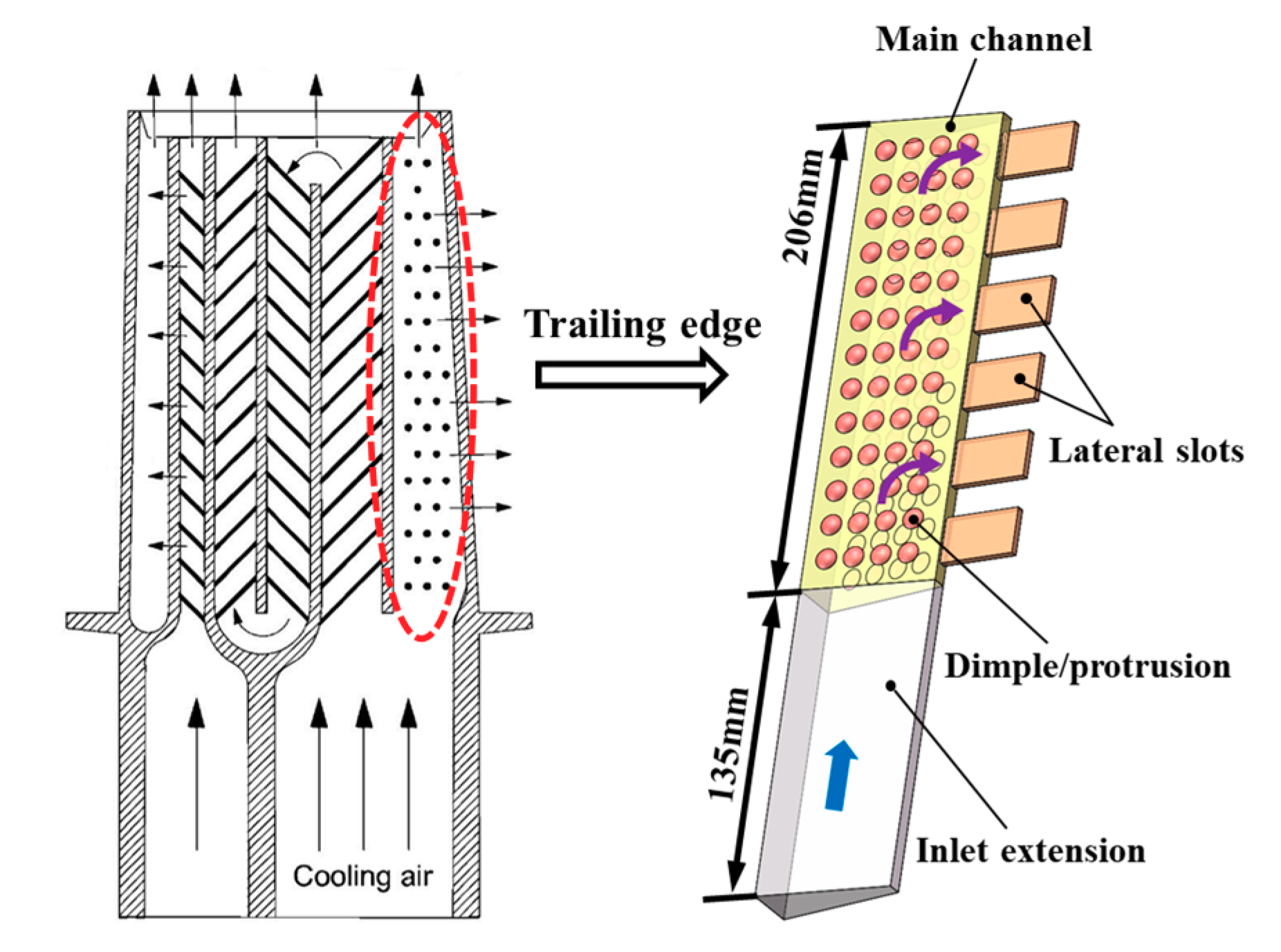
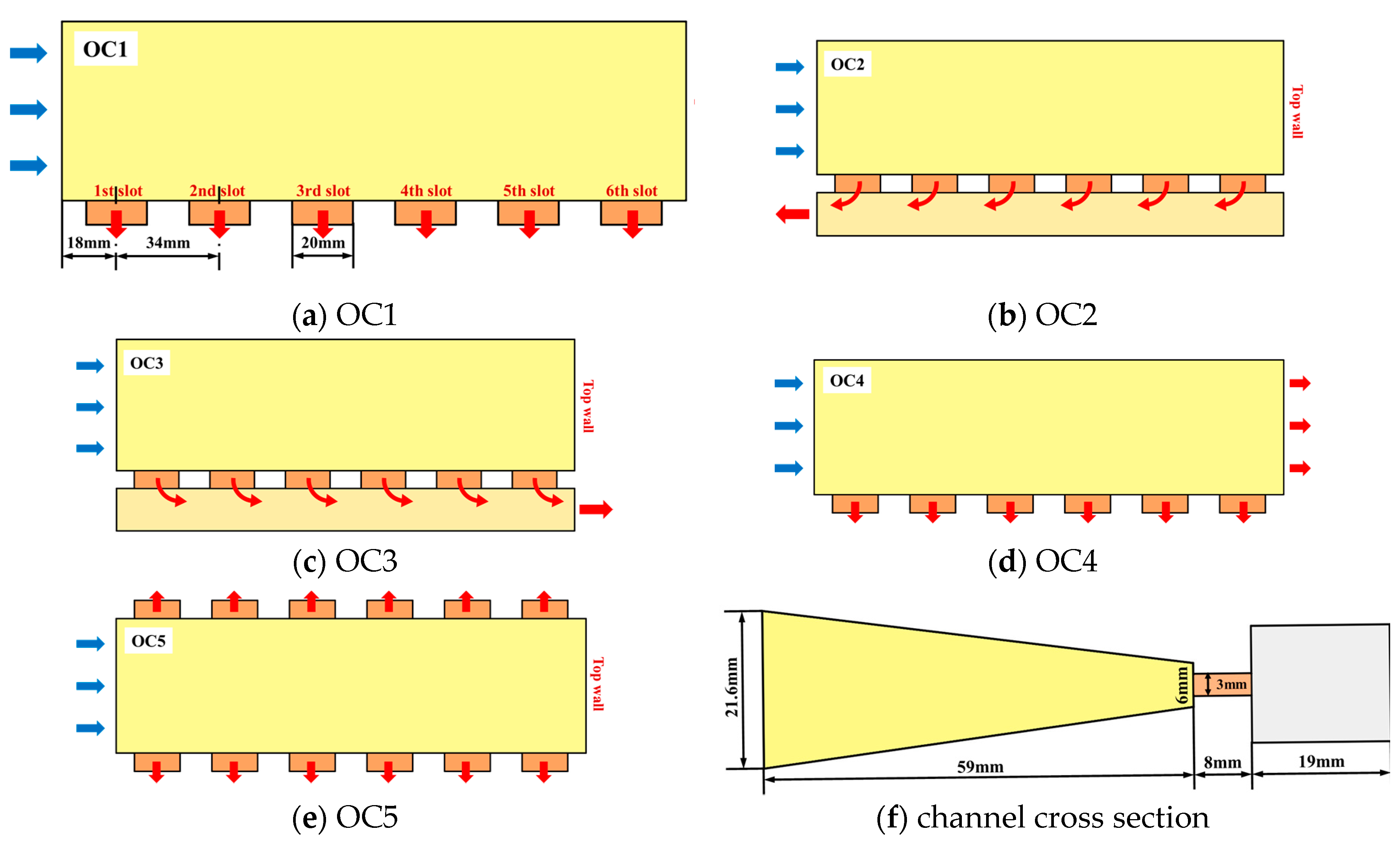

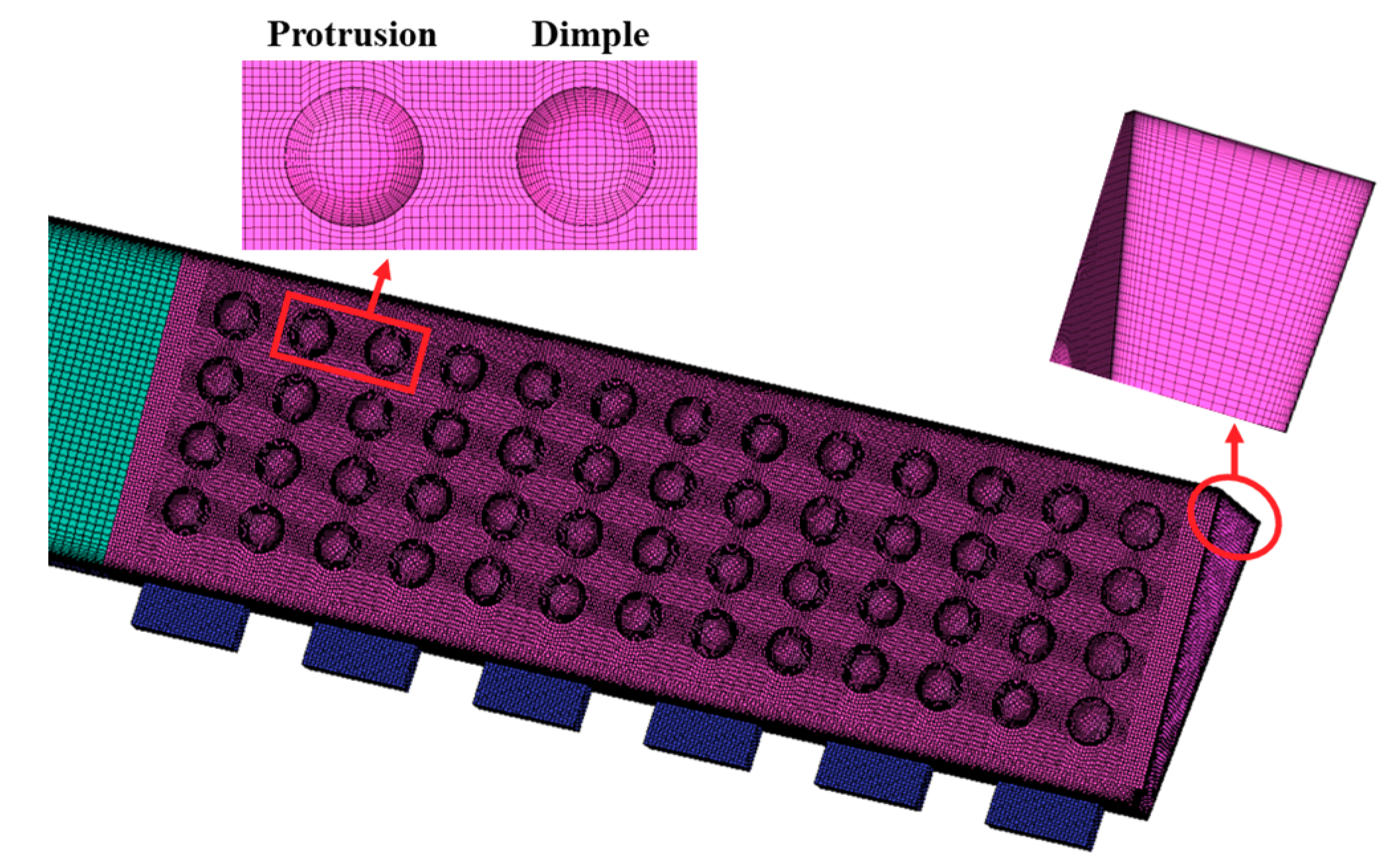
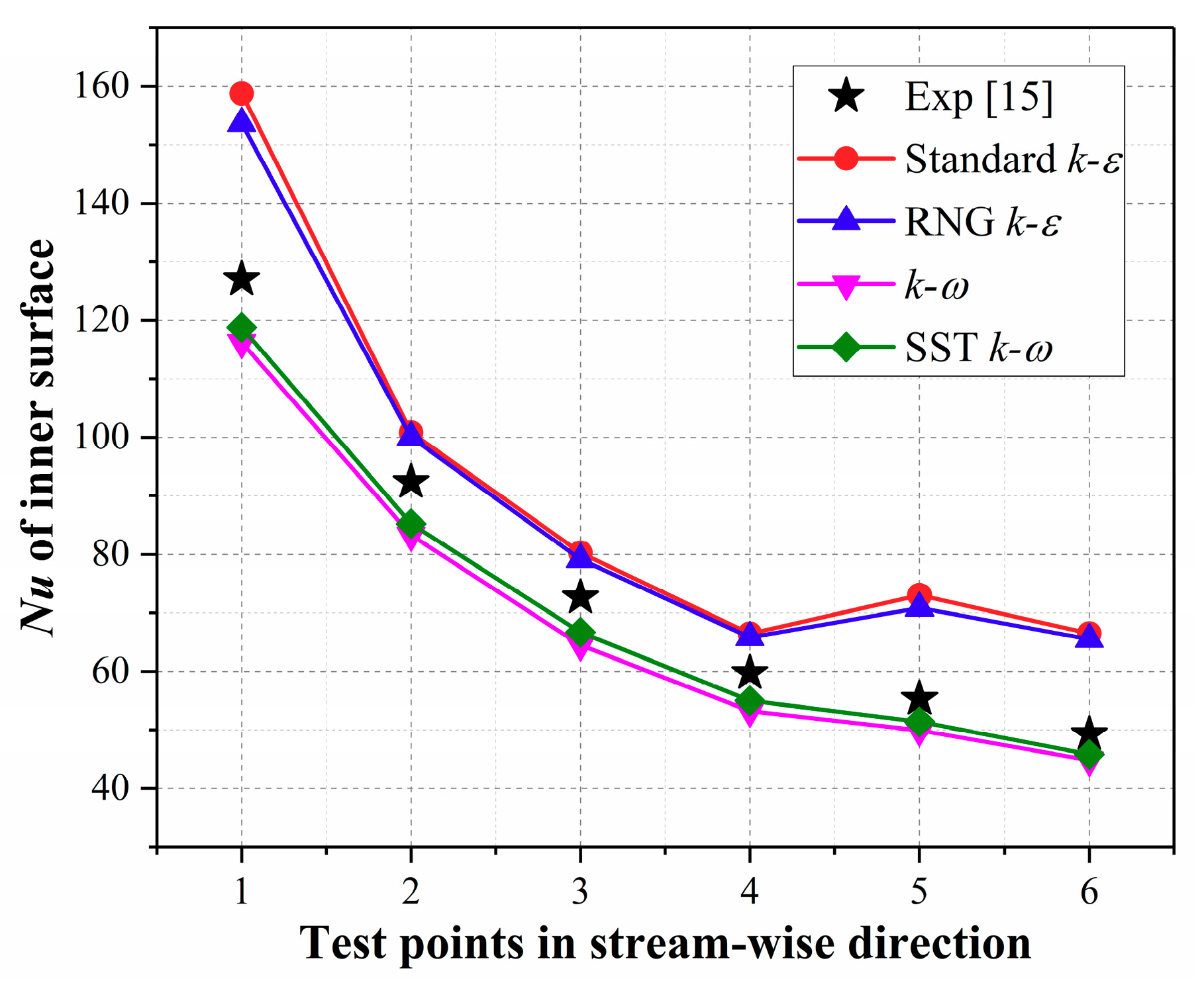

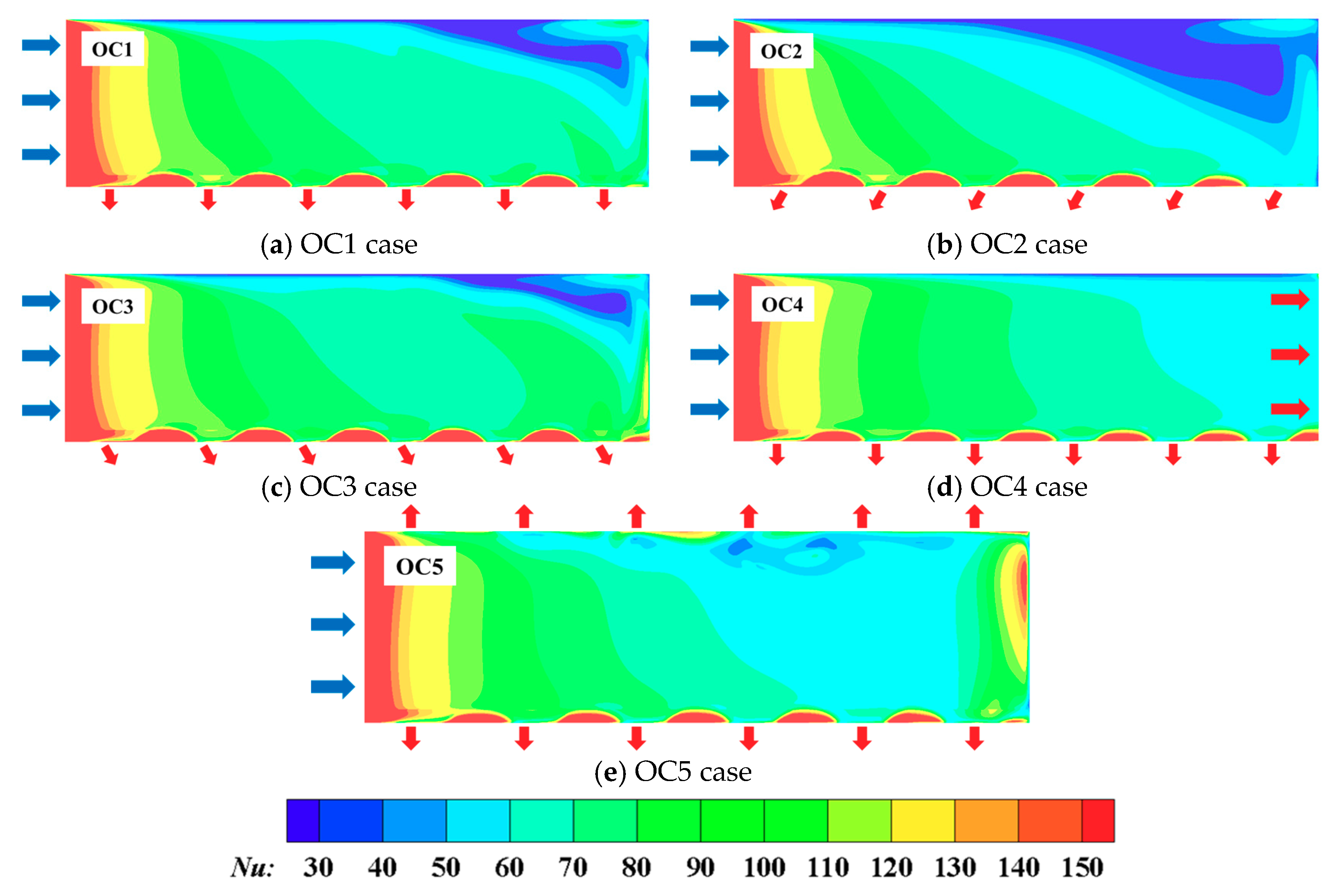
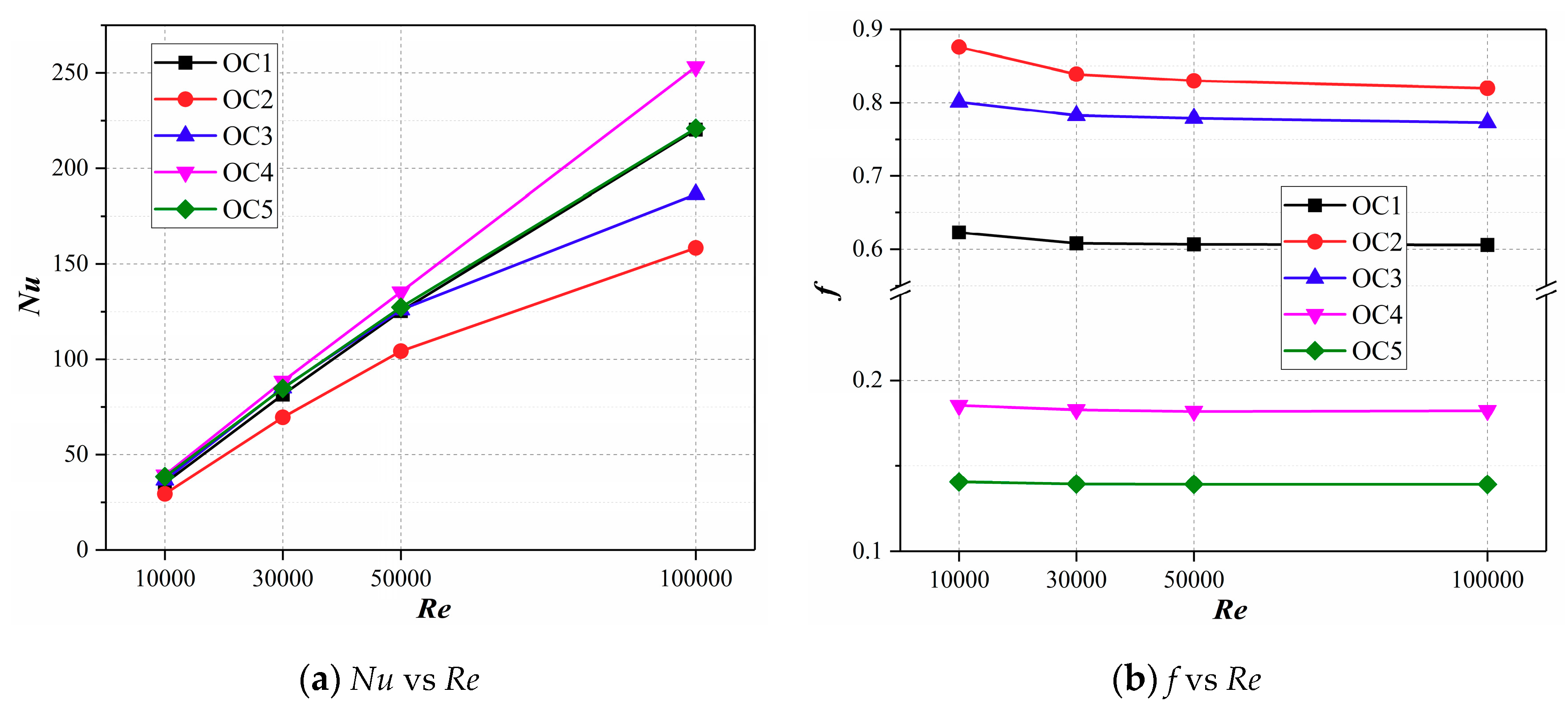

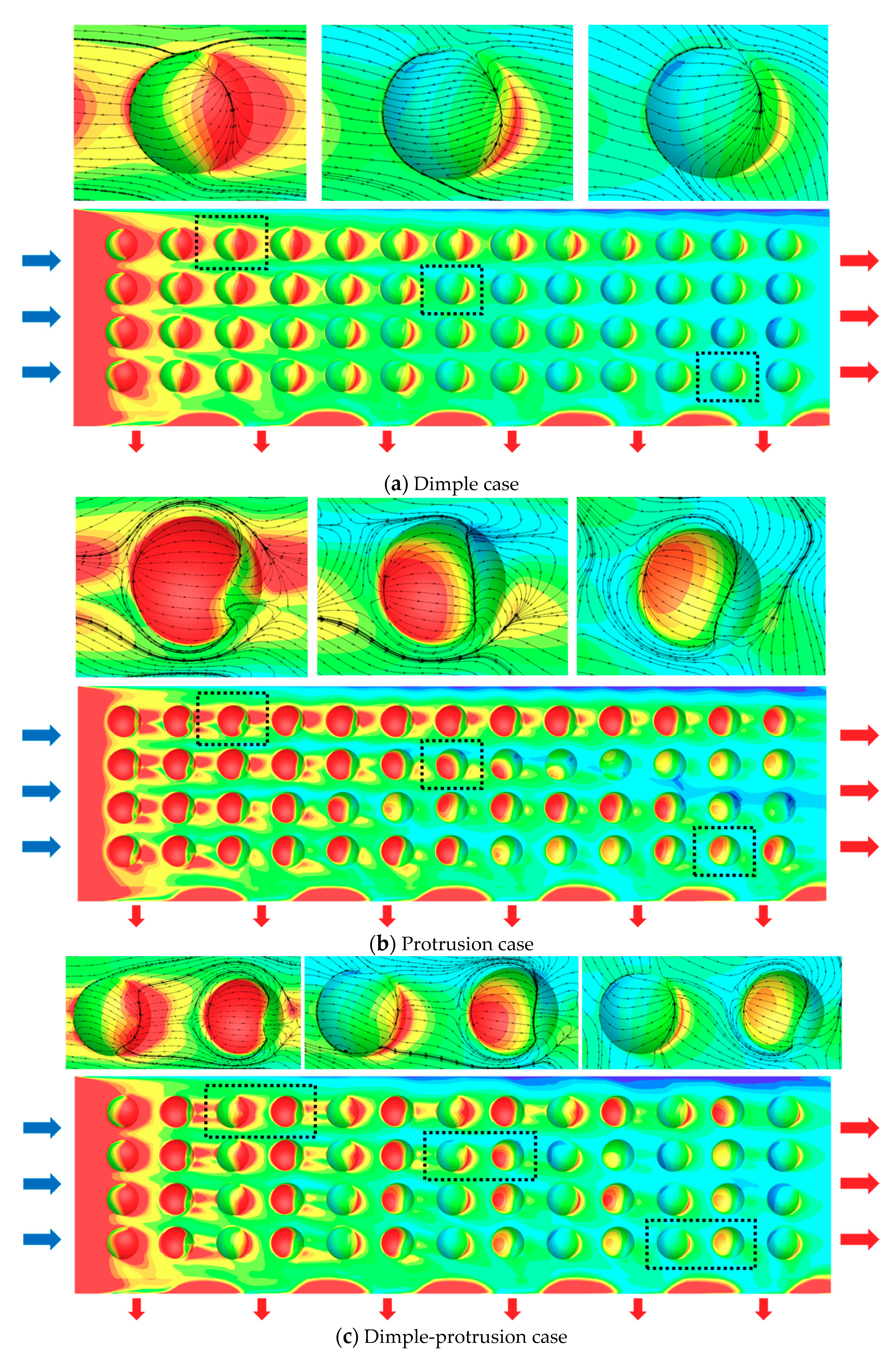

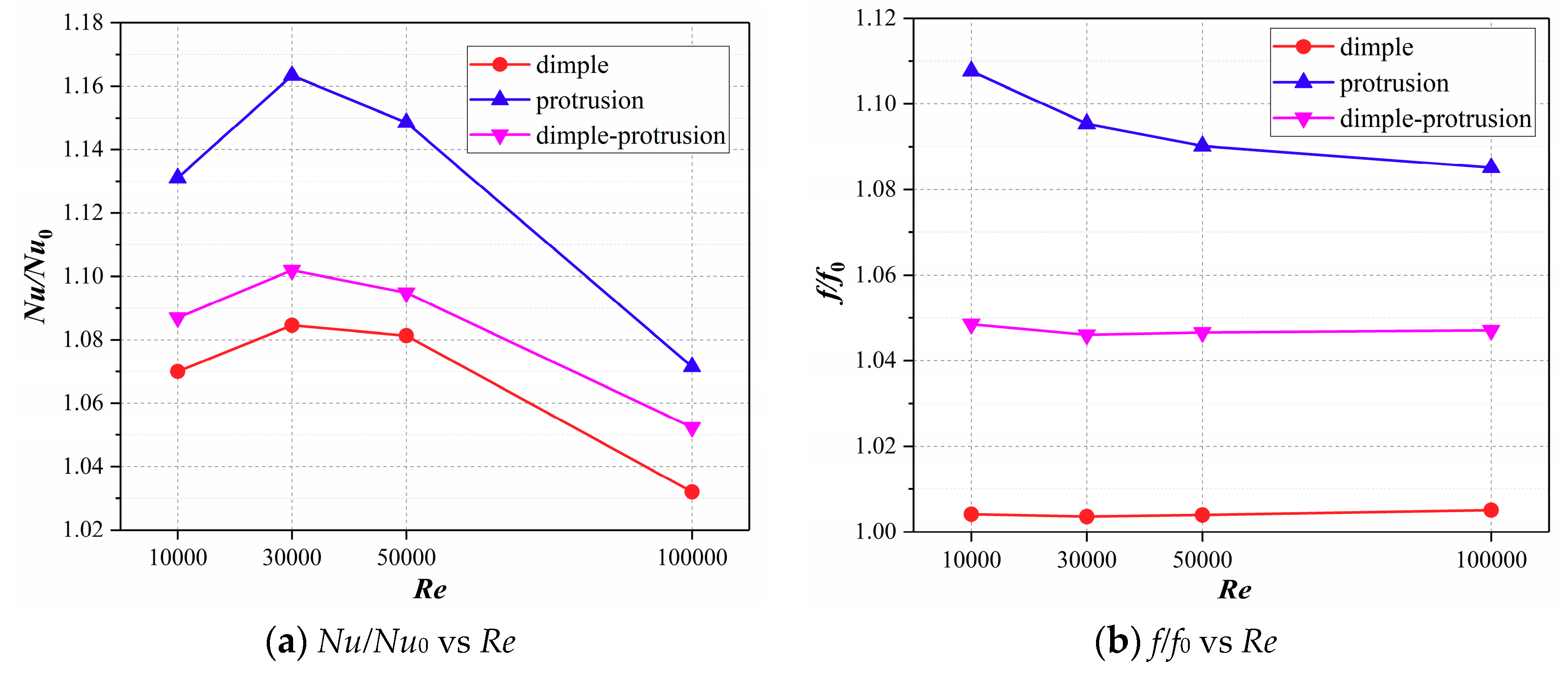

| Case | Outlet Configuration | Surface Structure | Re (104) |
|---|---|---|---|
| Part I | OC1 | smooth | 1/3/5/10 |
| OC2 | |||
| OC3 | |||
| OC4 | |||
| OC5 | |||
| Part II | OC4 | dimple | 1/3/5/10 |
| protrusion | |||
| dimple-protrusion |
| Grid Scheme | Node Number | h (W·m−2·K−1) | Error (%) | ΔP/l (Pa·m−1) | Error (%) |
|---|---|---|---|---|---|
| 1 | 1283219 | 48.31 | 0.56 | 483.87 | 0.59 |
| 2 | 2827536 | 48.58 | 0.08 | 486.73 | 0.09 |
| 3 | 5766132 | 48.62 | / | 487.18 | / |
© 2019 by the authors. Licensee MDPI, Basel, Switzerland. This article is an open access article distributed under the terms and conditions of the Creative Commons Attribution (CC BY) license (http://creativecommons.org/licenses/by/4.0/).
Share and Cite
Jing, Q.; Xie, Y.; Zhang, D. Effects of Channel Outlet Configuration and Dimple/Protrusion Arrangement on the Blade Trailing Edge Cooling Performance. Appl. Sci. 2019, 9, 2900. https://doi.org/10.3390/app9142900
Jing Q, Xie Y, Zhang D. Effects of Channel Outlet Configuration and Dimple/Protrusion Arrangement on the Blade Trailing Edge Cooling Performance. Applied Sciences. 2019; 9(14):2900. https://doi.org/10.3390/app9142900
Chicago/Turabian StyleJing, Qi, Yonghui Xie, and Di Zhang. 2019. "Effects of Channel Outlet Configuration and Dimple/Protrusion Arrangement on the Blade Trailing Edge Cooling Performance" Applied Sciences 9, no. 14: 2900. https://doi.org/10.3390/app9142900
APA StyleJing, Q., Xie, Y., & Zhang, D. (2019). Effects of Channel Outlet Configuration and Dimple/Protrusion Arrangement on the Blade Trailing Edge Cooling Performance. Applied Sciences, 9(14), 2900. https://doi.org/10.3390/app9142900





